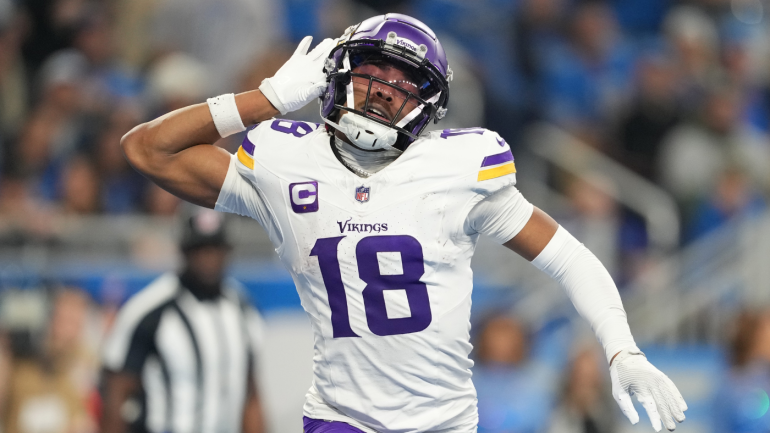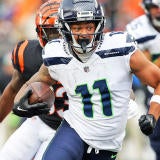
The era of going heavy on wide receivers is in full swing, and the tight end position has become stronger at the top than it has been in a long time.
Pair that with a running back slate that has added meaningful depth over the past two seasons and you'll have the makings of several pathways you can take to build your rosters this preseason.
The macro trends in football at this point are well-known, and they fit right in with what's happening in Fantasy Football. Teams are passing at high rates and using as many different people to catch passes as they can, especially when they don't have that Alpha-type receiver. This doesn't mean teams no longer like to run the ball -- they certainly will, especially if defenses continue to play zone coverage to scare offenses from throwing deep. But more teams than ever subscribe to a committee approach because it makes sense financially and structurally. Now when most teams lose a running back for a game, a month, or the season, the contingency plan is strong.

Fantasy Football Today Newsletter
Know What Your Friends Don't
Get tips, advice and news to win your league - all from the FFT podcast team.
Thanks for signing up!
Keep an eye on your inbox.
Sorry!
There was an error processing your subscription.
Implementing these concepts into Fantasy draft plans is pretty easy, but it's better to break it all down by position and lay out what you should do before you draft as well as what you might do once your draft is underway.
You'll also find my tiers for each position. I have been using them for almost two decades now as a way to sort not just who to take, but when. The tiers also show when there's a reduction in talent from one group of players to another based on expectations for Fantasy points. If you use these tiers as a baseline and then tweak them based on what you believe in and who you want to draft, you should not only be able to make easy decisions with each pick but also know in advance who you'll take with your next pick.
That makes drafting a lot less stressful and a lot more fun.
Wide Receiver Strategy
Facts are facts: The top 12 wide receivers have averaged more PPR points than the top-12 running backs in each of the past four years. And it's not just at the top -- receivers that finished 13th through 24th have also done better on average in PPR than their rushing counterparts.
That's why there's been a huge movement toward taking receivers over running backs early. The whole PPR thing also tilts the scales in the favor of wideouts too.
But this year's receiver crop is interesting. There are eight receivers in Tier 1 who are unpassable save for a few elite running backs, then the drop-off in each tier after is a little steeper than in the past. It doesn't mean the position isn't deep -- it is very deep -- but sorting through the wideouts from, say, 10th to 24th is challenging.
There are some one-year wonders (like Brandon Aiyuk and Nico Collins), a lot of WRs who SHOULD be awesome but haven't been yet (like Chris Olave and Drake London), and a bunch of older wideouts who have either shown signs of slowing down (like Davante Adams and Cooper Kupp) or could start slowing down this year (like Mike Evans, Stefon Diggs and Keenan Allen). There are simply not a lot of proven receivers with a clean, multi-year track record of consistency with high expectations under the age of 28.
So what's a Fantasy manager to do? Focus on what we were reminded of last year: Receivers with good roles in good offenses with capable quarterbacks can be difference-makers. Focusing on those types of receivers will give you a shot at unearthing the next Nacua or Collins. Those factors, along with the expected target volume that a receiver will have, are prevalent in the tiers. I tried hard to downgrade any wideout that didn't have at least one of these traits.
So it's a weird year, and it might be a transitional year where the fantasy stars of tomorrow blossom and the fantasy stars of yesterday fade. And if THAT'S the case, then it feels wise to target the up-and-comers and let the old guard get drafted by other people.
The most prominent strategy is the obvious one: Collect as many receivers you believe are must-starts while you can. Picking two from the first three tiers should be do-able while also swiping a running back. The more the league scoring and roster requirements are tilted to receivers, the more you should get after finding starters.
And if you wind up waiting on receiver, don't freak out. It will sting not having a stellar crew, but smart drafting from Tiers 4 through 6 could help you catch up, plus you'd theoretically be strong at other positions since you waited on receiver. It's not a death sentence for your Fantasy team and it might honestly be the way I'd go about my roster build in non-PPR.
Pre-draft homework:
* Do receptions count for a full point? If they do then prioritize wide receivers. If not, prioritize running backs.
* Can you start three or more wide receivers? If so, then prioritize the position. If not, don't.
* Go through a rankings list you trust and cross off the names of receivers you don't view as weekly must-starts. The more names you cross off, the more you should prioritize wide receivers.
Wide receiver PPR tiers
C. Lamb
DAL
CeeDee Lamb
DAL
|
T. Hill
MIA
Tyreek Hill
MIA
|
J. Jefferson
MIN
Justin Jefferson
MIN
|
J. Chase
CIN
Ja'Marr Chase
CIN
|
A. St. Brown
DET
Amon-Ra St. Brown
DET
|
A. Brown
PHI
A.J. Brown
PHI
|
G. Wilson
NYJ
Garrett Wilson
NYJ
|
P. Nacua
LAR
Puka Nacua
LAR
|
M. Harrison Jr.
ARI
Marvin Harrison Jr.
ARI
|
C. Olave
NO
Chris Olave
NO
|
D. London
ATL
Drake London
ATL
|
D. Adams
LV
Davante Adams
LV
|
B. Aiyuk
SF
Brandon Aiyuk
SF
|
D. Samuel
SF
Deebo Samuel
SF
|
M. Pittman
IND
Michael Pittman
IND
|
C. Kupp
LAR
Cooper Kupp
LAR
|
N. Collins
HOU
Nico Collins
HOU
|
M. Evans
TB
Mike Evans
TB
|
J. Waddle
MIA
Jaylen Waddle
MIA
|
D. Metcalf
SEA
DK Metcalf
SEA
|
T. Higgins
CIN
Tee Higgins
CIN
|
D. Smith
PHI
DeVonta Smith
PHI
|
A. Cooper
CLE
Amari Cooper
CLE
|
G. Pickens
PIT
George Pickens
PIT
|
S. Diggs
HOU
Stefon Diggs
HOU
|
C. Kirk
JAC
Christian Kirk
JAC
|
C. Ridley
TEN
Calvin Ridley
TEN
|
T. McLaurin
WAS
Terry McLaurin
WAS
|
C. Godwin
TB
Chris Godwin
TB
|
M. Nabers
NYG
Malik Nabers
NYG
|
J. Reed
GB
Jayden Reed
GB
|
Z. Flowers
BAL
Zay Flowers
BAL
|
L. McConkey
LAC
Ladd McConkey
LAC
|
R. Rice
KC
Rashee Rice
KC
|
J. Addison
MIN
Jordan Addison
MIN
|
D. Johnson
CAR
Diontae Johnson
CAR
|
C. Watson
GB
Christian Watson
GB
|
K. Allen
CHI
Keenan Allen
CHI
|
M. Brown
KC
Marquise Brown
KC
|
D. Hopkins
TEN
DeAndre Hopkins
TEN
|
X. Worthy
KC
Xavier Worthy
KC
|
J. Smith-Njigba
SEA
Jaxon Smith-Njigba
SEA
|
K. Coleman
BUF
Keon Coleman
BUF
|
R. Odunze
CHI
Rome Odunze
CHI
|
J. Williams
DET
Jameson Williams
DET
|
B. Thomas Jr.
JAC
Brian Thomas Jr.
JAC
|
C. Sutton
DEN
Courtland Sutton
DEN
|
K. Shakir
BUF
Khalil Shakir
BUF
|
T. Lockett
SEA
Tyler Lockett
SEA
|
T. Franklin
DEN
Troy Franklin
DEN
|
J. Jeudy
CLE
Jerry Jeudy
CLE
|
R. Doubs
GB
Romeo Doubs
GB
|
J. Palmer
LAC
Josh Palmer
LAC
|
J. Polk
NE
Ja'Lynn Polk
NE
|
J. Dotson
WAS
Jahan Dotson
WAS
|
R. Wilson
PIT
Roman Wilson
PIT
|
M. Corley
NYJ
Malachi Corley
NYJ
|
J. Meyers
LV
Jakobi Meyers
LV
|
D. Wicks
GB
Dontayvion Wicks
GB
|
X. Legette
CAR
Xavier Legette
CAR
|
Wide receiver non-PPR tiers
C. Lamb
DAL
CeeDee Lamb
DAL
|
T. Hill
MIA
Tyreek Hill
MIA
|
J. Chase
CIN
Ja'Marr Chase
CIN
|
J. Jefferson
MIN
Justin Jefferson
MIN
|
A. Brown
PHI
A.J. Brown
PHI
|
A. St. Brown
DET
Amon-Ra St. Brown
DET
|
G. Wilson
NYJ
Garrett Wilson
NYJ
|
P. Nacua
LAR
Puka Nacua
LAR
|
M. Harrison Jr.
ARI
Marvin Harrison Jr.
ARI
|
B. Aiyuk
SF
Brandon Aiyuk
SF
|
D. Samuel
SF
Deebo Samuel
SF
|
C. Olave
NO
Chris Olave
NO
|
D. London
ATL
Drake London
ATL
|
D. Adams
LV
Davante Adams
LV
|
C. Kupp
LAR
Cooper Kupp
LAR
|
N. Collins
HOU
Nico Collins
HOU
|
M. Evans
TB
Mike Evans
TB
|
J. Waddle
MIA
Jaylen Waddle
MIA
|
D. Metcalf
SEA
DK Metcalf
SEA
|
D. Smith
PHI
DeVonta Smith
PHI
|
T. Higgins
CIN
Tee Higgins
CIN
|
M. Pittman
IND
Michael Pittman
IND
|
A. Cooper
CLE
Amari Cooper
CLE
|
G. Pickens
PIT
George Pickens
PIT
|
C. Ridley
TEN
Calvin Ridley
TEN
|
S. Diggs
HOU
Stefon Diggs
HOU
|
T. McLaurin
WAS
Terry McLaurin
WAS
|
C. Kirk
JAC
Christian Kirk
JAC
|
M. Nabers
NYG
Malik Nabers
NYG
|
Z. Flowers
BAL
Zay Flowers
BAL
|
J. Reed
GB
Jayden Reed
GB
|
C. Godwin
TB
Chris Godwin
TB
|
R. Rice
KC
Rashee Rice
KC
|
C. Watson
GB
Christian Watson
GB
|
M. Brown
KC
Marquise Brown
KC
|
J. Addison
MIN
Jordan Addison
MIN
|
L. McConkey
LAC
Ladd McConkey
LAC
|
X. Worthy
KC
Xavier Worthy
KC
|
K. Allen
CHI
Keenan Allen
CHI
|
C. Sutton
DEN
Courtland Sutton
DEN
|
D. Johnson
CAR
Diontae Johnson
CAR
|
J. Smith-Njigba
SEA
Jaxon Smith-Njigba
SEA
|
D. Hopkins
TEN
DeAndre Hopkins
TEN
|
K. Coleman
BUF
Keon Coleman
BUF
|
R. Odunze
CHI
Rome Odunze
CHI
|
J. Williams
DET
Jameson Williams
DET
|
B. Thomas Jr.
JAC
Brian Thomas Jr.
JAC
|
K. Shakir
BUF
Khalil Shakir
BUF
|
T. Franklin
DEN
Troy Franklin
DEN
|
T. Lockett
SEA
Tyler Lockett
SEA
|
J. Palmer
LAC
Josh Palmer
LAC
|
J. Jeudy
CLE
Jerry Jeudy
CLE
|
J. Dotson
WAS
Jahan Dotson
WAS
|
R. Doubs
GB
Romeo Doubs
GB
|
J. Polk
NE
Ja'Lynn Polk
NE
|
R. Shaheed
NO
Rashid Shaheed
NO
|
J. Meyers
LV
Jakobi Meyers
LV
|
R. Wilson
PIT
Roman Wilson
PIT
|
X. Legette
CAR
Xavier Legette
CAR
|
M. Corley
NYJ
Malachi Corley
NYJ
|
D. Wicks
GB
Dontayvion Wicks
GB
|
Which sleepers, breakouts and busts should you target and fade, and which RB shocks the NFL with a top-10 performance? Visit SportsLine now to get cheat sheets for every single position, all from the model that nailed Deebo Samuel as a bust last year, and find out.

















